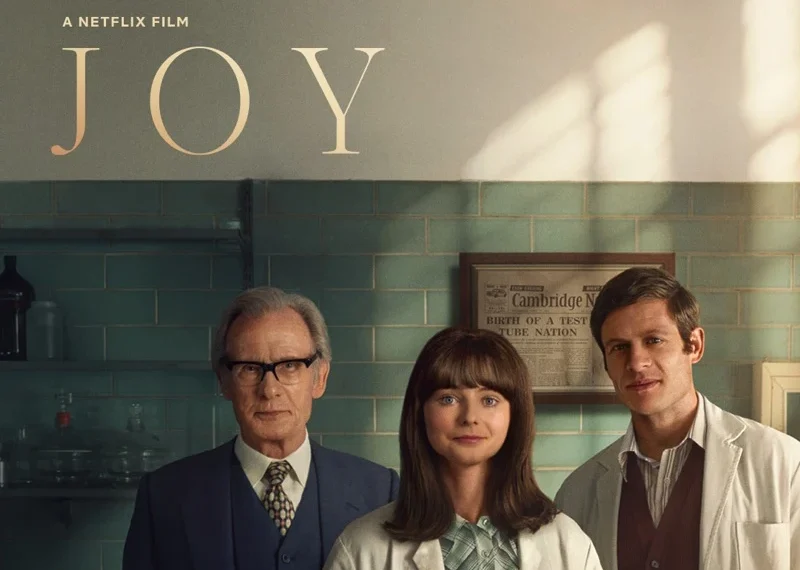Cast: Thomasin McKenzie, James Norton and Bill Nighy
Genre: Biography, Drama, History
Director: Ben Taylor
In Irish Cinemas: 15th November 2024
Streaming on Netflix: 22nd November 2024
The title “Joy” has been a recurring choice in recent films and media. Still, a new movie about the pioneering battle to develop in-vitro fertilisation (IVF) makes a strong case for reusing it. In a touching reveal near the film’s end, audiences learn that “Joy” was the middle name of Louise Joy Brown, the world’s first “test-tube baby” and a living testament to a breakthrough that took over a decade of controversial and emotionally fraught medical experimentation to achieve. However, “joy” here signifies more than just historical symbolism; it is the guiding spirit of this first feature film by British TV comedy director Ben Taylor, known for hits like Sex Education and Catastrophe. Taylor approaches the complex subject with an unexpected tone of optimism, striving to create a feel-good story out of material often defined by profound loss and heartache.
Even in the present, IVF remains an uphill journey for countless hopeful parents. Success rates hover below 50%, and high costs place the procedure out of reach for many, leading to heart-wrenching disappointment more often than joyful success. While IVF has resulted in the birth of at least 12 million children worldwide over the past 45 years, it has left even more families grappling with unfulfilled dreams. Taylor’s film thus not only celebrates the scientific and personal triumphs surrounding IVF’s invention but also acknowledges the painful reality and emotional resilience faced by those pursuing this path to parenthood.
Jack Thorne’s script for Joy tackles the tonal complexity of its subject matter by shifting the spotlight away from a patient directly undergoing fertility treatment and instead centring on someone equally devoted to its success: Jean Purdy, a young British nurse who joined a male-dominated fertility research team as an assistant in 1969. Over the years, Purdy’s role evolved significantly, and she became an essential member of the team as an embryologist in the lead-up to Louise Brown’s groundbreaking birth in 1978, the first successful in vitro fertilisation (IVF) baby.
Portrayed by Thomasin McKenzie with a blend of earnest determination and quiet resilience, Purdy serves in the film both as an uncelebrated pioneer and as a relatable guide for the audience. She navigates the often patronising, patriarchal environment of 1970s scientific research with unyielding practicality, her common sense and emotional intelligence cutting through the detached scientific jargon and egos surrounding her.
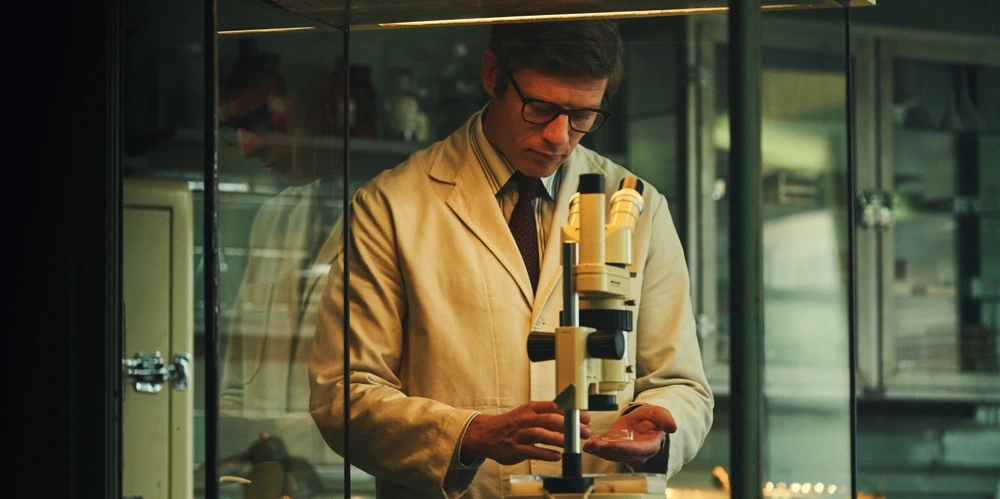
Purdy’s own thwarted dreams of motherhood—complicated by her working-class background and devout religious beliefs—are hinted at in the film but not immediately revealed. Joy holds back this detail, allowing it to emerge gradually, underscoring Purdy’s sacrifices for a cause greater than herself. The film, however, doesn’t fully delve into the complexities of Purdy’s character or explore the lasting emotional impact of her life’s work. Instead, she is introduced as a hopeful, idealistic young woman applying for a job at Cambridge’s research lab under the supervision of Dr. Bob Edwards (played with endearing absentmindedness by James Norton). At this point, Edwards’ early IVF experiments are still tentative and limited to animal trials.
Purdy’s contributions to IVF weren’t officially acknowledged until years after her untimely death from cancer at 39. Still, Joy pays homage to her role as a vital yet overlooked force behind a historic scientific achievement. Through her story, the film sheds light on the often invisible labour that has paved the way for advancements in fertility science.

The team realises they need an obstetrician’s expertise, and into the picture steps Patrick Steptoe, portrayed with typical elegance and dry wit by Bill Nighy. Steptoe is a seasoned doctor at a rundown, underfunded hospital in Oldham, further north, who is gruff and good-hearted. He’s unafraid to challenge the establishment, a necessary boldness in an era when the concept of conceiving a child outside the human body is seen by much of British society as an unnatural, even grotesque, violation. Fueled by a conservative backlash from both the church and sensationalist tabloids, public opinion is hostile; the press even brands Edwards as “Dr. Frankenstein” once word of his experiments leaks out.
When Purdy’s conservative mother, Gladys (played by Joanna Scanlan), learns the true nature of her daughter’s work, she’s horrified, barring her from the family home. Purdy’s love life offers a subplot as she shares a tentative romance with junior doctor Arun (Rish Shah), a sweet but awkward young man. The relationship hints at the possibility of a settled, domestic future. Still, Purdy resists, instinctively feeling that a conventional nuclear family isn’t in her cards, especially as her groundbreaking work in reproductive medicine becomes all-consuming.

The early parts of Joy lean into a gentle, almost cosy tone, bringing humour to the growing pains among the mismatched trio of Purdy, the well-meaning but socially awkward Edwards, and the world-weary Steptoe. As they navigate their differing personalities and develop a collaborative rhythm, the film weaves in cheerful pop-soul hits from the period. At the same time, Jamie Cairney’s cinematography bathes the scenes in warm, sunlit tones, offsetting the gritty landscapes of Greater Manchester. Even Sinéad Kidao’s costume design feels snug and inviting with its tweedy, vintage textures.
However, as the project encounters repeated setbacks—from failed experiments to rejected funding proposals—the film’s initial lightness fades, giving way to moments of frustration and quiet devastation. Yet, Joy tends to downplay the depth of pain in this struggle, particularly for the women participating in these trials. Many of these women, collectively known as “The Ovum Club,” have been informed that they are more likely to pave the way for future mothers than become mothers themselves. At one point, one of these hopeful patients reproaches Purdy for treating them impersonally, like “cattle,” prompting her to re-evaluate her approach. Edwards, too, faces criticism from a colleague for his clinical language regarding these women but later reveals a more profound empathy, reciting each patient’s name from memory as a testament to his dedication.
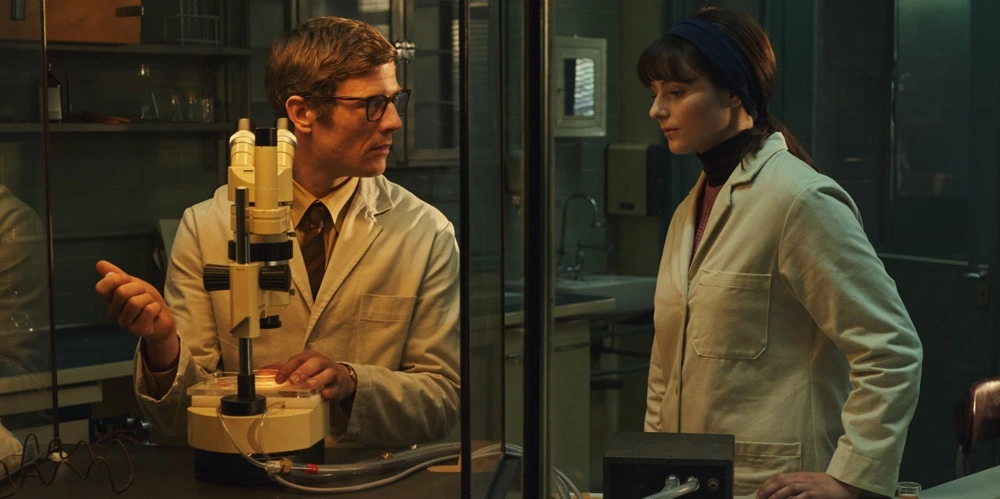
Yet, the film could delve deeper into these women’s inner lives. Some of their backstories—one hints at being a survivor of domestic abuse, while another briefly reacts to the news of an ectopic pregnancy—are touched on only briefly and left largely unresolved. While the film aims for collective uplift by showing Purdy gathering these women for a joyful beach outing, this montage seems more symbolic than substantive, a gesture that skirts the true complexities of their experiences.
“Joy” is a profoundly moving film that resonates with the universal emotions tied to our choices—or sometimes, life’s choices—in building our families. The film stirs a profound sense of empathy, prompting viewers to reflect on their experiences and desires as they follow the story. Following a grand premiere at the London Film Festival, “Joy” will touch countless hearts when it makes its way to Netflix. It will invite audiences to immerse themselves in its narrative and recognise their longings, sacrifices, and hopes.
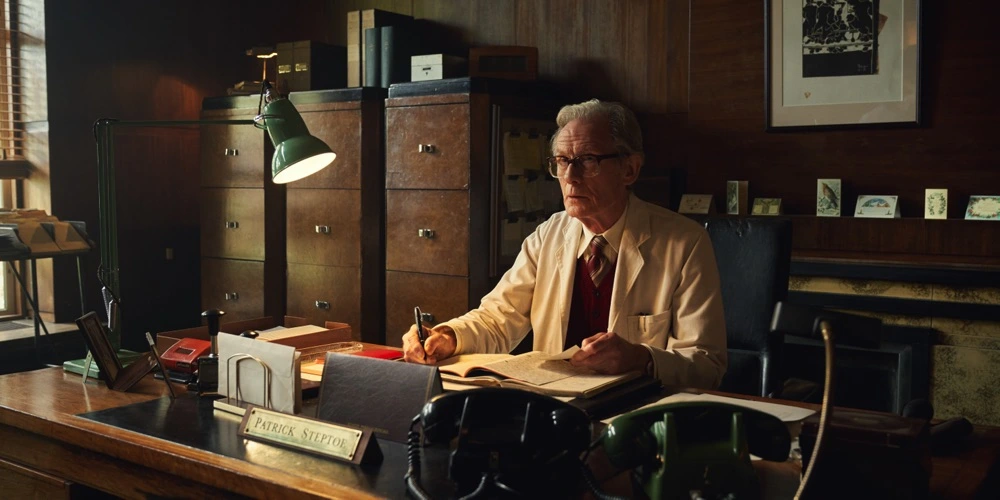
Despite Thomasin McKenzie’s sincere portrayal, her character, Purdy, often serves as a vessel for her patients’ collective heartache and yearning, almost as much as she exists as a distinct individual. This dual role makes Purdy both accessible and tragic, as her struggles mirror those of many. Her quiet revelation to her mother, Gladys—that she’s been trying for ten years to conceive, leaving her hopes pinned on the chance of an unplanned pregnancy—catches us off-guard, as it does Gladys. The moment subtly yet powerfully underscores the depth of Purdy’s unspoken longing and the quiet resignation that has shaped her life.
The film is framed by a voiceover from Joy Edwards, portrayed by Leslie Norton, who advocates for Purdy’s inclusion on the plaque commemorating the first successful IVF birth at Oldham Hospital. Edwards’ voice serves as a poignant reminder that the achievements of doctors don’t solely define medical milestones; they’re often made possible by the courage and resilience of patients like Purdy, whose personal sacrifices pave the way for others. “Joy” honours this truth, giving Purdy a place of recognition alongside the male doctors of her time, lifting her name and story to an equal footing with theirs.
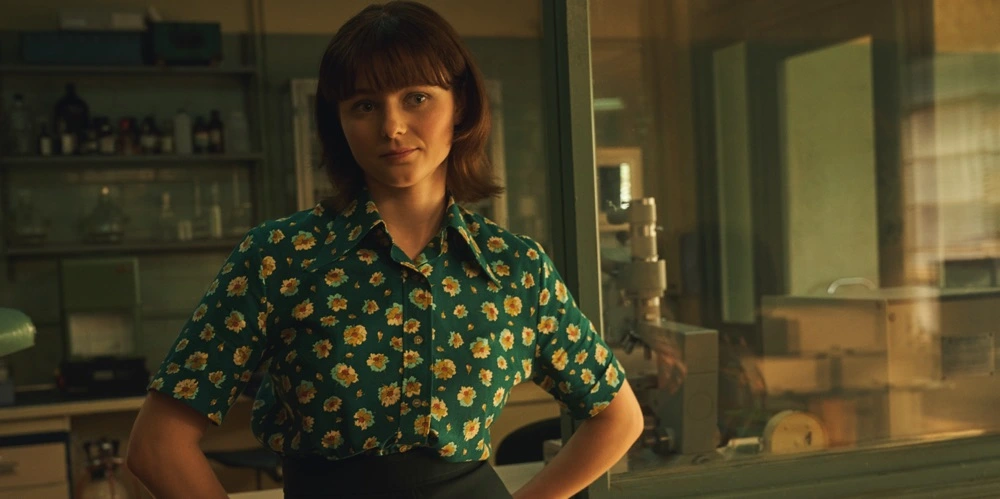
Yet, even with this acknowledgement, Purdy’s legacy remains an ineffable sadness. The plaque immortalises her contribution, yet the personal life behind her name—the dreams, losses, and silent endurance—is something we’re left to imagine, as it remains partially obscured, just out of reach. “Joy” thus serves as both a tribute to progress and a quiet elegy for those whose personal stories are entwined with it but remain forever elusive.
Overall: 6/10

